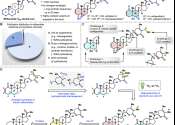Researchers develop scalable synthesis of cancer-fighting compounds
Withanolides, a class of naturally occurring compounds found in plants, have long been a focus of cancer research due to their ability to inhibit cancer cell growth, induce cell death and prevent metastasis. These compounds ...
12 hours ago
0
20









